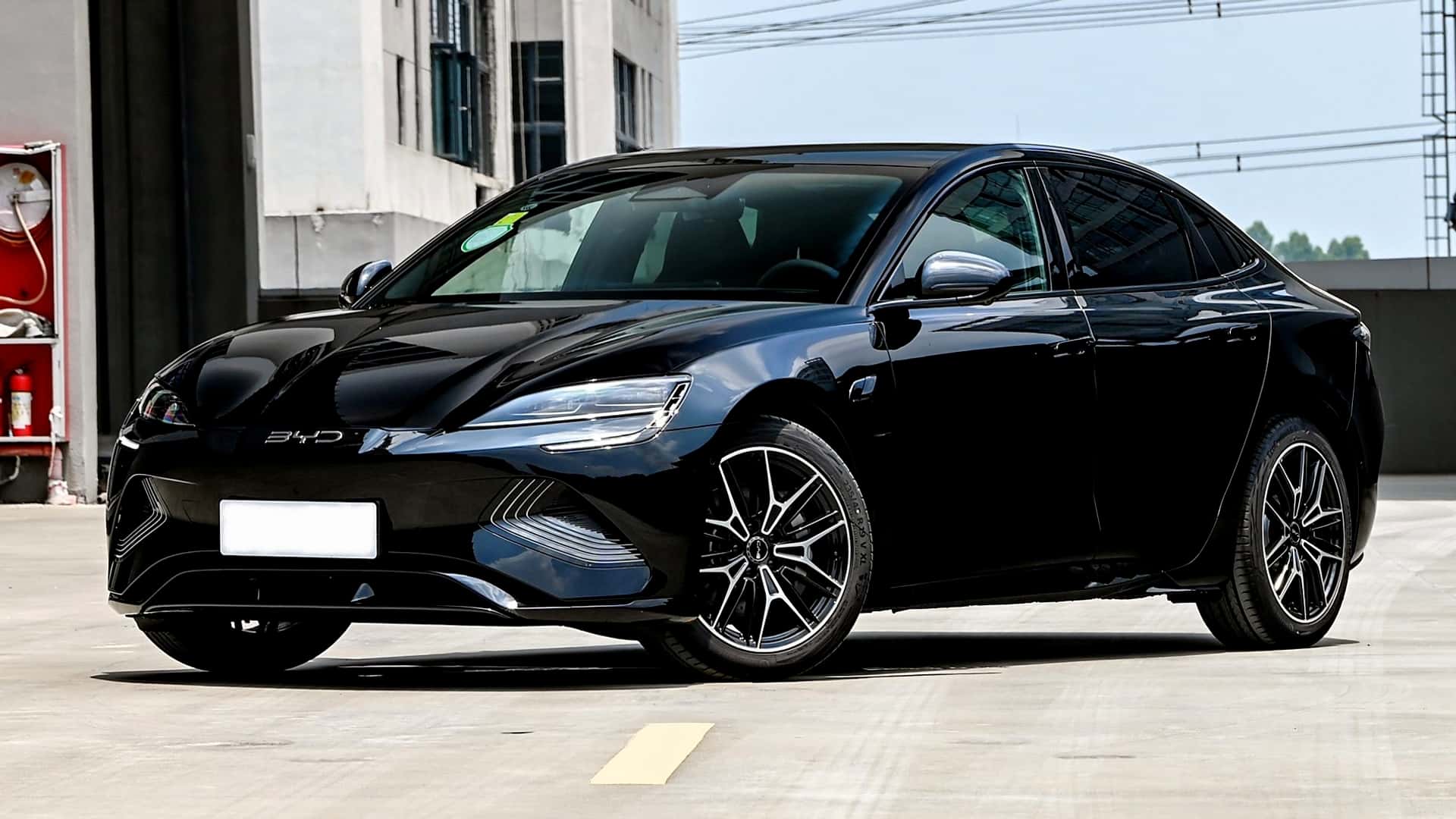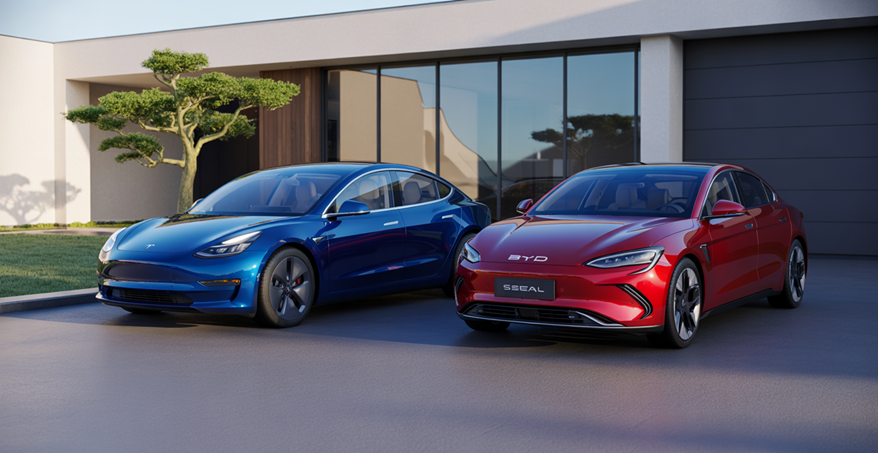How China’s top EV contender is shaking up the American electric car landscape.
The American electric vehicle (EV) market, long dominated by Tesla, is facing an ambitious and fast-rising challenger from the East: BYD, the Chinese automaker that now stands as one of the world’s largest producers of EVs. With the recent U.S. entry of the BYD Seal, a sleek, high-performance sedan, American consumers are forced to confront a critical question: Can these Chinese EVs be trusted?
This comprehensive comparison between the 2025 BYD Seal and the 2025 Tesla Model 3 examines more than just specifications — it dives into technology, pricing, quality, safety, resale value, and market dynamics, delivering everything you need to evaluate the changing EV landscape.
BYD Seal: A formidable rival or just another import?

The 2025 BYD Seal, priced between $34,990 and $44,990, enters U.S. showrooms with undeniable confidence. Sleek, minimalist, and riding on BYD’s cutting-edge e-Platform 3.0, the Seal brings serious performance credentials. The top variant pushes 0–60 mph in just 3.8 seconds, thanks to dual motors producing 530 hp and 670 Nm of torque.
Its 82.5 kWh LFP Blade Battery, developed in-house by BYD, supports fast charging from 10% to 80% in under 30 minutes and delivers a real-world range of around 310 miles for the dual-motor version. The Blade Battery technology is known for its high thermal stability, significantly reducing risks of thermal runaway and increasing consumer confidence in EV safety.
The cabin rivals any European luxury brand, with a 15.6-inch rotating infotainment screen, synthetic leather upholstery, adaptive cruise control, and a robust ADAS package. Wireless Apple CarPlay, Android Auto, and over-the-air updates are standard, reflecting BYD’s intent to meet — or exceed — U.S. tech expectations.
Tesla Model 3: America’s benchmark isn’t standing still

The updated 2025 Tesla Model 3, with a price range of $38,990 to $51,990, continues to lead the EV pack in many areas — particularly with superior software integration, charging infrastructure, and brand loyalty. The latest refresh brings an improved interior layout, enhanced soundproofing, and better build quality, addressing many of the early criticisms.
Tesla’s Single Motor RWD offers a 272-mile range, while the Long Range AWD stretches to 341 miles under optimal conditions. Acceleration remains brisk, with the Performance variant sprinting from 0–60 mph in 3.1 seconds, narrowly beating the BYD Seal.
Beyond the numbers, Tesla’s Supercharger network continues to be a critical advantage, offering reliable, widespread access to fast charging that no other automaker — including BYD — can yet match on American soil.
Build quality and trust: Is BYD ready for America?
Trust in a vehicle goes beyond powertrains and range — it lies in build integrity, reliability, and service infrastructure. While Tesla had years to build its ecosystem in the U.S., BYD is entering relatively cold. Currently, service centers and parts availability for BYD in North America are limited, but aggressive partnerships with U.S. logistics and dealer networks are underway to close this gap by mid-2025.
In terms of build quality, early reviews from European and Australian markets (where the Seal has already launched) consistently praise BYD for tight panel gaps, high-quality materials, and strong reliability ratings. The Blade Battery’s safety record, now supported by five years of global deployment, is a key element in building consumer trust.
Tech wars: Autonomy and infotainment
Tesla’s Full Self-Driving (FSD) software — still in beta but improving — gives the Model 3 a clear lead in semi-autonomous capability. While BYD’s advanced driver-assist suite is capable (featuring lane centering, traffic jam assist, and automatic emergency braking), it lacks the same level of software maturity and driver behavior modeling.
However, BYD strikes back with a far more intuitive and customizable infotainment experience, including physical buttons where needed, avoiding Tesla’s more polarizing minimalist approach. BYD also leads in in-cabin comfort, offering ventilated seats, ambient lighting, and superior sound isolation.
Price vs. performance: Who delivers more for less?
For budget-conscious buyers, the BYD Seal undercuts the Model 3 by up to $7,000 while offering more standard features, a larger battery, and comparable performance. This value proposition becomes even more compelling if U.S. federal EV tax credits apply, though eligibility depends on domestic content regulations — an ongoing challenge for Chinese manufacturers.
Tesla, on the other hand, justifies its price premium through network reliability, resale value, and software leadership. For many, that’s worth the added cost. But as BYD expands its footprint and proves itself over time, that calculus may begin to shift.
Long-term support and resale
Resale value is one of the most overlooked yet critical components of total vehicle cost. Tesla vehicles historically retain strong resale values, buoyed by high demand and consistent over-the-air updates that keep older models fresh.
BYD is still untested in this regard in the U.S., and resale predictions remain speculative. However, if reliability, battery longevity, and software support remain strong, the Seal could position itself as a smart long-term investment.
Should American buyers trust a Chinese EV?
Trust isn’t granted — it’s earned. BYD is making all the right moves: world-class battery tech, competitive pricing, premium design, and a commitment to safety. But for many Americans, skepticism around data privacy, geopolitics, and support infrastructure may continue to be barriers.
For buyers focused on value, safety, and innovation, the BYD Seal is more than worthy of consideration. For those prioritizing ecosystem maturity, charging convenience, and brand trust, the Tesla Model 3 still holds the crown — for now.
Key takeaways
-
BYD Seal starts at $34,990, offering high-end performance and next-gen battery safety.
-
Tesla Model 3 starts at $38,990, dominating in charging, resale, and autonomy.
-
BYD leads in interior quality and value per dollar, but trails in U.S. support and brand familiarity.
-
Tesla remains a software and infrastructure leader, though BYD is rapidly closing in.
In a rapidly evolving EV market, American consumers now face a more dynamic, competitive landscape. The question isn’t just about trusting Chinese EVs — it’s about recognizing the global evolution of mobility and making informed decisions based on facts, not assumptions.


